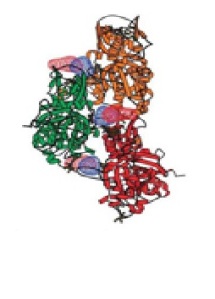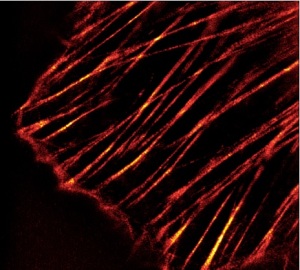Actin can be stained in living and fixed cells to determine and follow the structure and function of the cytoskeleton. The actin cytoskeleton is a very dynamic and labile structure in the living cell, but it can be fixed by either cold methanol or paraformaldehyde prior to probing or staining for actin structures.
Actin staining in fixed cells

In fixed cells, actin structures can be visualized by actin antibodies, fluorescent phalloidins, or even electron microscopy.
Antibodies recognize both monomer and polymer (filamentous or F-actin) actin and hence tend to have a high background compared to probes that bind only F-actin. Well designed fluorescent phalloidins only bind to the native quaternary structure of F-actin and therefore have a low background. To create the correct fixation conditions for phalloidin binding, paraformaldehyde must be used as the fixative because it retains the quanternary protein structure which is necessary for high affinity. Methanol destroys the native conformation and hence is not suitable for actin staining with phalloidin.
Cytoskeleton Inc. offers a set of phalloidin based stains (Acti-Stains) coupled to a number of different fluorophores compatible with popular filter sets such as FITC, TRITC and Cy5. The stains are exceptionally bright and stable and are indeed offered at very economical prices compared to other phalloidin based stains coupled to fluorophores of similar stability.

There are four colours to choose among:
- Acti-stain 488 phalloidin
- Acti-stain 535 Phalloidin (Rhodamine phalloidin)
- Acti-stain 555 phalloidin
- Acti-stain 670 phalloidin
Actin staining in living cells
Up to now, the options for live cell staining of Actin (as well as Tubulin) were limited. The only methods for live cell imaging available so far have been systems based on expression vectors which have to be transfected to target cells. In the case of Actin, a binding protein is coupled to either GFP or RFP and thus is expressed in target cells which leads to a labeling of F-actin. Such an experimental approach can bring major technical hurdles such as transfection efficiency and duration.
Non-toxic Actin fluorescent stains for live-cell imaging
Spirochrome recently released unique fluorescent stains for monitoring Actin (and Tubulin) easily in living cells. These fluorescent stains (SiR-Actin and SiR-Tubulin) are cell permeable compounds which stain F-actin (and microtubules, respectively) in living cells.

The benefits are obvious:
- No transfection
- No washing steps
- No toxic effects
- Excellent brightness
- Far-red excitation & emission
- Deep tissue penetration and minimal background
- Multiple fluorescent stainings with other dyes possible
If you’re interested in more information about these stains, take a look at my recent post 2 new Actin and Tubulin live-cell imaging stains – without transfection!
What do you think about these products? Have you tried any of them already? Leave your questions or comments below!



